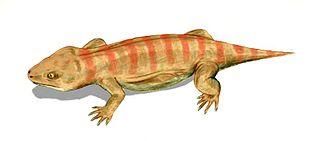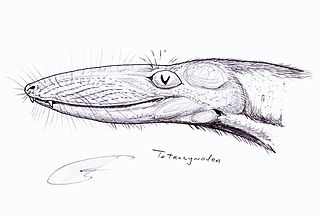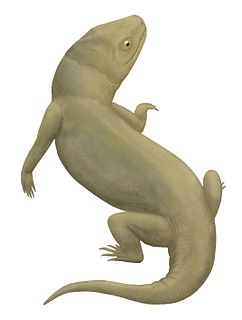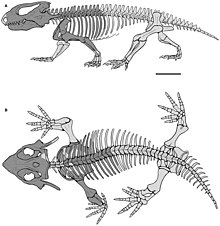
Milleretta is an extinct genus of millerettid parareptile from the Late Permian of South Africa. Fossils have been found in the Balfour Formation. Milleretta was a moderately sized, lizard-like animal, about 60 centimetres (24 in) in length. It was probably insectivorous. Its only known species is Milleretta rubidgei, making Milleretta a monospecific genus.

The Procolophonia are a suborder of herbivorous reptiles that lived from the Middle Permian till the end of the Triassic period. They were originally included as a suborder of the Cotylosauria but are now considered a clade of Parareptilia. They are closely related to other generally lizard-like Permian reptiles such as the Millerettidae, Bolosauridae, Acleistorhinidae, and Lanthanosuchidae, all of which are included under the Anapsida or "Parareptiles".

Procolophonomorpha is an order or clade containing most parareptiles. Many papers have applied various definitions to the name, though most of these definitions have since been considered synonymous with modern parareptile clades such as Ankyramorpha and Procolophonia. The current definition of Procolophonomorpha, as defined by Modesto, Scott, & Reisz (2009), is that of as a stem-based group containing Procolophon and all taxa more closely related to it than to Milleretta. It constitutes a diverse assemblage that includes a number of lizard-like forms, as well as more diverse types such as the pareiasaurs. Lee 1995, 1996, 1997 argues that turtles evolved from pareiasaurs, but this view is no longer considered likely. Rieppel and deBraga 1996 and deBraga and Rieppel, 1997 argue that turtles evolved from sauropterygians, and there is both molecular and fossil (Pappochelys) evidence for the origin of turtles among diapsid reptiles.

Procolophonidae is an extinct family of small, lizard-like parareptiles known from the Late Permian to Late Triassic that were distributed across Pangaea, having been reported from Europe, North America, China, South Africa, South America, Antarctica and Australia. The most primitive procolophonids were likely insectiovous or omnivorous, more derived members of the clade developed bicusped molars, and were likely herbivorous feeding on high fiber vegetation or durophagous omnivores. Many members of the group are noted for spines projecting from the quadratojugal bone of the skull, which likely served a defensive purpose as well as possibly also for display. At least some taxa were likely fossorial burrowers. While diverse during the Early and Middle Triassic, they had very low diversity during the Late Triassic, and were extinct by the beginning of the Jurassic.

Procolophon is a genus of lizard-like procolophonid parareptiles that first appeared in the Early Triassic (Induan) of South Africa, Brazil, and Antarctica. It persisted through the Permian–Triassic extinction event, but went extinct in the beginning of the Early Middle Triassic. The type species is P. trigoniceps.

Leptopleuron is an extinct genus of procolophonid that lived in the dry lands during the late Triassic in Elgin of northern Scotland and was the first to be included in the clade of Procolophonidae. First described by English paleontologist and biologist Sir Richard Owen, Leptopleuron is derived from two Greek bases, leptos for "slender" and pleuron for "rib," describing it as having slender ribs. The fossil is also known by a second name, Telerpeton, which is derived from the Greek bases tele for "far off" and herpeton for "reptile." In Scotland, Leptopleuron was found specifically in the Lossiemouth Sandstone Formation. The yellow sandstone it was located in was poorly lithified with wind coming from the southwest. The environment is also described to consist of barchan dunes due to the winds, ranging up to 20 m tall that spread during dry phases into flood plains. Procolophonoids such as Leptopleuron were considered an essential addition to the terrestrial ecosystem during the Triassic.

Tetracynodon is an extinct genus of therocephalian. Fossils of Tetracynodon have been found in the Karoo Basin of South Africa. Two species are known: the type species T. tenuis from the Late Permian and the species T. darti from the Early Triassic. Both species were small-bodied and probably fed on insects and small vertebrates. Although Tetracynodon is more closely related to mammals than it is to reptiles, its braincase is very primitive and shares more in common with modern amphibians and reptiles than it does with mammals.

Colobomycter is an extinct genus of lanthanosuchoid parareptile known from the Early Permian of Oklahoma.

Acleistorhinidae is an extinct family of Late Carboniferous and Early Permian-aged parareptiles. Acleistorhinids are most diverse from the Richards Spur locality of the Early Permian of Oklahoma. Richards Spur acleistorhinids include Acleistorhinus, Colobomycter, and possibly Delorhynchus and Feeserpeton. Other taxa include Carbonodraco from the Late Carboniferous of Ohio and Karutia from the Early Permian of Brazil. Acleistorhinidae is commonly considered a subgroup of lanthanosuchoids, related to taxa such as Chalcosaurus, Lanthaniscus and Lanthanosuchus. However, a re-examination of parareptile phylogeny conducted by Cisneros et al. (2021) argued that lanthanosuchids were not closely related to acleistorhinids. The phylogenetic analysis conducted by these authors recovered acleistorhinids as the sister group of the clade Procolophonia, while lanthanosuchids were recovered within the procolophonian subgroup Pareiasauromorpha.

Acleistorhinus (ah-kles-toe-RYE-nuss) is an extinct genus of parareptile known from the Early Permian of Oklahoma. It is notable for being the earliest known anapsid reptile yet discovered. The morphology of the lower temporal fenestra of the skull of Acleistorhinus bears a superficial resemblance to that seen in early synapsids, a result of convergent evolution. Only a single species, A. pteroticus, is known, and it is classified in the Family Acleistorhinidae, along with Colobomycter.

Owenetta is an extinct genus of owenettid procolophonian parareptile. Fossils have been found from the Beaufort Group in the Karoo Basin of South Africa. Although most procolophonians lived during the Triassic, Owenetta existed during the Wuchiapingian and Changhsingian stages of the Late Permian as well as the early Induan stage of the Early Triassic. It is the type genus of the family Owenettidae, and can be distinguished from other related taxa in that the posterior portion of the supratemporal bears a lateral notch and that the pineal foramen is surrounded by a depressed parietal surface on the skull table.

Owenettidae is an extinct family of procolophonian parareptiles. Fossils have been found primarily from Africa and Madagascar, with one genus present from South America. It is the sister taxon to the family Procolophonidae.

Microleter is an extinct genus of basal procolophonomorph parareptiles which lived in Oklahoma during the Early Permian period. The type and only known species is Microleter mckinzieorum. Microleter is one of several parareptile taxa described from the Richards Spur fissure fills, and can be characterized from its high tooth count, lacrimal/narial contact, short postfrontal, and slit-like temporal emargination edged by the postorbital, jugal, squamosal, and quadratojugal. Contrary to Australothyris, which had a similar phylogenetic position as a basal procolophonomorph, Microleter suggests that early parareptile evolution occurred in Laurasia and that multiple lineages developed openings or emarginations in the temporal region.

Candelaria is an extinct genus of owenettid parareptile. It was the first procolophonomorph discovered in the Santa Maria Formation at the geopark of Paleorrota, in the town of Candelária, by Llewellyn Ivor Price in 1942 and described in 1947. The skull and mandible has been measured at 20 millimetres (0.79 in) in height. It was about 40 centimetres (16 in) long and lived during the Ladinian in the Middle Triassic, from about 242 to 235 million years ago.

Sauropareion is an extinct genus of basal procolophonid parareptile from earliest Triassic deposits of Eastern Cape Province, South Africa. It is known from the holotype SAM PK-11192, skull and partial postcranium. It was collected by the late L. D. Boonstra in 1935 from Barendskraal in the Middelburg District and referred to the Lystrosaurus Assemblage Zone of the Beaufort Group. It was first named by Sean P. Modesto, Hans-Dieter Sues and Ross J. Damiani in 2001 and the type species is Sauropareion anoplus. The generic name means "lizard", sauros, and "cheek", pareion from Greek in reference to the lizard-like appearance of the temporal region. The specific name comes from the Greek word anoplos, meaning "without arms or armour".
Coletta is an extinct genus of basal procolophonid parareptile from Early Triassic deposits of Eastern Cape Province, South Africa. It is known from the holotype GHG 228, a skull with fragmentary lower jaws. It was collected on the farm Brakfontein 333 in the Cradock District. It was found in the Katberg Formation of the Beaufort Group and referred to the Lystrosaurus Assemblage Zone. It was first named by Christopher E. Gow in 2000 and the type species is Coletta seca.

Ankyramorpha is an extinct clade of procolophonomorph parareptiles which lived between the early Cisuralian epoch to the latest Triassic period of Africa, Antarctica, Asia, Australia, Europe, North America and South America.
Nyctiphruretidae is an extinct family of hallucicranian parareptiles known from the late Early to the late Middle Permian of European Russia and south-central United States.
Barasaurus is an extinct genus of owenettid procolophonoid parareptile known from the late Late Permian and early Early Triassic of Madagascar. It contains a single species, Barasaurus besairiei.

Pareiasauromorpha is a group of parareptilian amniotes from the Permian. It includes genera found all over the world, with many genera from Asia and South Africa. The clade was first used as a group by Linda A. Tsuji in 2011, in order to group the family Nycteroleteridae (nycteroleters) and the superfamily Pareiasauroidea (pareiasaurs). Pareiasauromorpha is considered to be a monophyletic node, the sister group to procolophonoids.






















